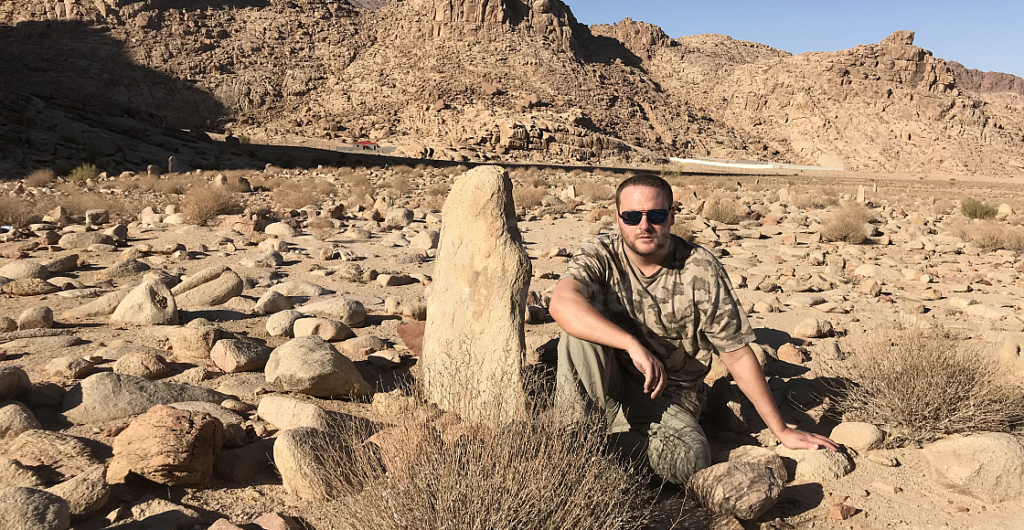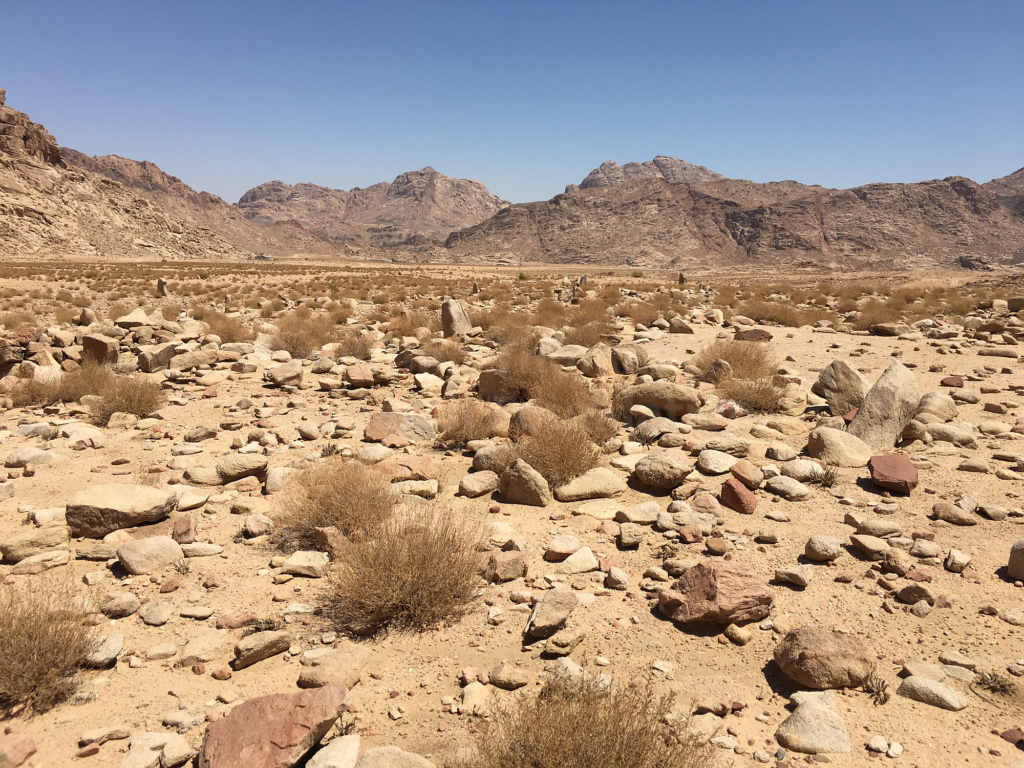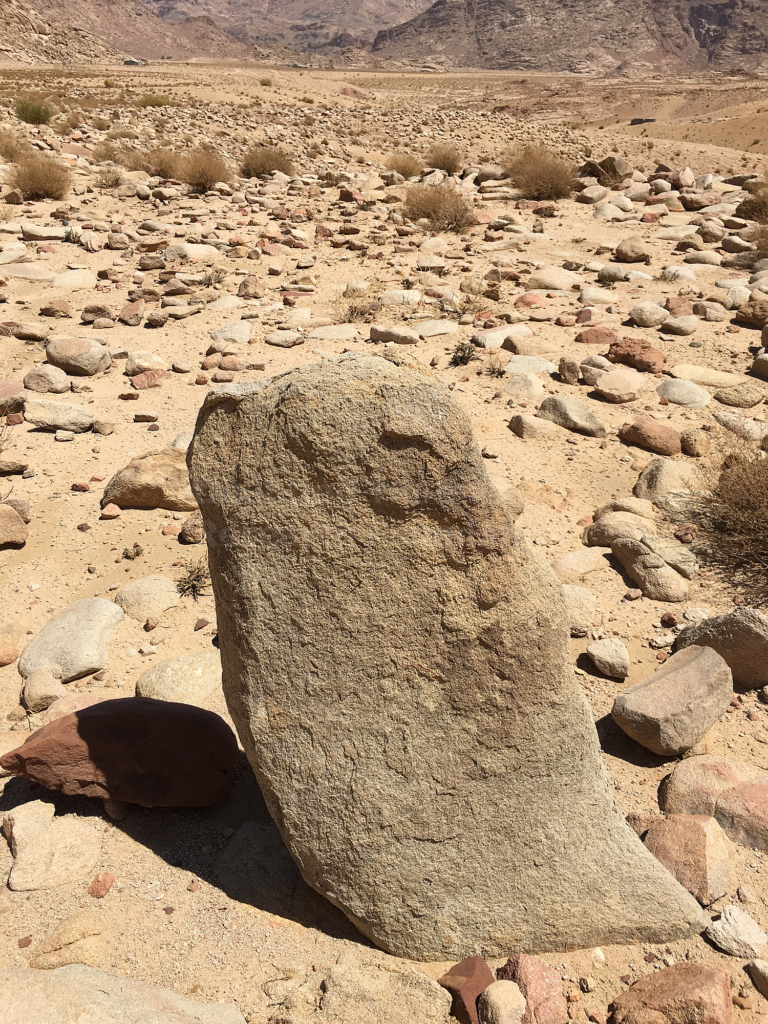An Ancient Graveyard Near The Golden Calf Site

Approximately 4 miles from the location we believe to be the Golden Calf Worship site is a large, ancient, and undeniably pre-Islamic graveyard that is fenced off. It is marked as an archaeological site by the Saudis and a police station is nearby.
If Jabal Maqla is the real Mount Sinai, then this graveyard may be where the 3,000 Golden Calf worshipers were buried after they were killed for their idolatry. It may also be the burial spot where the 20,000 Israelites who died from the plague associated with this event were buried.
The location of the graveyard makes sense within the context of the Exodus story. The graveyard would not be allowed near the holy precinct in front of the mountain, nor would it be within the large plain where the Israelites camped. The graveyard is on the outer edge to the north, just outside the plain and off the path that they would have traveled. It is where one would logically expect it to be.
The graveyard is definitely pre-Islamic because the use of upright headstones is forbidden in Islam. The site appears to be from ancient times, however, no scientific dating has been published thus far. Even so, some researchers believe it is most likely a Bronze Age site due to the style of some of the burials.
This includes the presence of tumuli, cairns, and standing stones - which are typically associated with ancient burial practices found in Arabia and are also noted to be practices some of the early Patriarchs in Genesis engaged in (i.e. standing stones).
Although the Bronze Age is a broad archaeological period, if this is the time period to which these graves belong, the Exodus falls within this timeframe.
Dr. Glen Fritz, in his latest book, The Exodus Mysteries: Of Midian, Sinai, and Jabal al-Lawz, has suggested that if an excavation of this site was ever permitted, Carbon 14 and DNA analysis of the people buried in the graves could help determine a more precise age for the gravesite, as well as who the occupants of the graves were.
In a personal correspondence with Dr. Fritz, we asked if he thought a good methodology for potential DNA analysis would be to compare DNA remnants of the grave occupants at this site in Saudi Arabia with DNA extracted from Semitic graves at Avaris in Egypt (where many of the Israelites resided during the sojourn/enslavement period).
Dr. Fritz replied that our suggestions were "Good thoughts!" (personal communication with Glen Fritz via email).
This would be a way to conclusively determine if these graves do, in fact, belong to the Golden Calf worshippers. This is because it could potentially show a genetic connection between Semitic (Israelite) burials in Egypt, prior to the Exodus, and the people buried at this gravesite in KSA.
Whether or not conducting an official excavation at this site will become possible though is hard to say.
The graveyard is approximately 300-400 yards across, about as big as a football field. Analysis of overhead imagery indicates that the graves are laid out in organized rows of rectangles and squares, and that these graves were probably dug all at the same time.
"The rock distribution pattern and the uniform degree of patina suggests a concentrated period of activity, not a serial accrual over many centuries."
Dr. Glen Fritz, "The Exodus Mysteries: Of Midian, Sinai, and Jabal al-Lawz," page 205
In our view and the view of other researchers, this site fits the description of a mass burial site.
The headstones are a variety of sizes. Jim and Penny Caldwell, an American couple who lived in Saudi Arabia and explored the area in the early 1990's, theorize that the largest headstones may represent a family instead of a single person. Unfortunately, there are holes next to many of the headstones, indicating they have been raided by grave-robbers.
The Saudi government has not publicly addressed the purpose of this site to our knowledge. The team of archaeologists who were commissioned by the Saudi government and published a rebuttal to the Sinai in Arabia theory in 2002 did not mention the graveyard.





Thanks to my fatһer who stated to me regarding this blog, this weblog
is genuinely amazing.
Have you considered scanning the ground of the graveyard? Since they committed such a terrible sin, do you speculate that they would have been buried in a box or just dropped into the ground? If you could get DNA samples, I wonder what it would show. The DNA is probably too old though.
That’s an interesting idea. I’m not sure what equipment we would need for that though, but it may be something to look into in the future.
It’s really unclear how they were buried. Given that this desert has little vegetation or trees, I don’t think it’s likely they were put into anything like a casket. The slain were more likely just buried as they were in the ground. As to whether they were all placed in individual graves, or one mass grave, that’s also unclear.
The Biblical record doesn’t give us many details on what happened immediately after the Golden Calf incident. What we do know is that this graveyard is certainly not Islamic, so one of the few theories that makes sense of this spot is that this is where those people who were killed after the Golden Calf incident were buried.
Starożytne DNA nie zachowa się w takich ciepłych terenach przez około 3500 lat. jeśli wcześniej ktoś specjalnie nie przygotował do tego ciała i grobu.
I am wondering if the laws concerning a 7 day cleansing after handling a human corpse were in effect at the time this happened. It appears from the text that those instructions came later. Who would have gathered up these bodies to be buried and how would they have transported them 4 miles off? Would they have had to observe a period of separation from the camp afterwards?
Even though the cleansing laws did not yet exist, the Almighty Creator no doubt had Moses wait with Joshua and Aaron for 7 days because Moses needed a 7 day time of cleansing, having handled the dead, before going into the cloud atop Mt. Sinai.
Could it be that this graveyard was started with the Hebrew dead that were killed in the battle with the Amalekites? This would explain why they were pressed to be in the Wilderness of Sinai on the same day they had left Rephidim, on that 3rd New Moon Day.
That’s a good question actually! Exodus 17 does not tell us how many Hebrews were killed in the battle with the Amalekites, only that they defeated the aggressing nation. From Rephidim to the mountain, it’s a fairly short distance, certainly doable in one day, so they weren’t necessarily hurried over there.
Based on our current research, we believe it is more likely to be where the Golden Calf worshipers were buried. If new evidence comes to light, though, we will certainly take a closer look at it!
Even though the cleansing laws did not yet exist, the Almighty Creator no doubt had Moses wait with Aaron and Hue for 7 days because Moses needed a 7 day time of cleansing, having handled the dead, before going into the cloud atop Mt. Sinai.
Correction, Moses went up with Joshua and left Aaron and Hur with the people.
Great research on these Biblical findings! I’m wondering if a metal detector or the equipment that Ron Wyatt’s Team used to scan the ground for any interruptions within the layers or open pockets i.e. caves when searching for the Ark of the Covenant would help? Since these pagan idol worshippers handed over some of their gold for the calf construction, maybe they were still wearing some additional jewelry when killed?
Good dɑy! This is my first visit to your blog! We are a team of volunteers and ѕtarting a new initіative in a community іn the samе niche.
Your bⅼog provided us beneficial informatіon to work on. Υou have done
a extraordinary job!
The disgraced, executed idolators were likely buried unceremoniously in mass graves; that is unless there are 3000+ vertical grave stones. The vertical grave stones are likely for those who fell in battle with the Amalekites.
Interesting idea Daniel! Thank you so much for sharing with us! Our friend and colleague Dr. Glen Fritz believes that the golden calf worshipers would have been buried unceremoniously as well. Although we feel this site is connected to the golden calf incident, we’re definitely open to hearing other interpretations of what it could be. We’re hopeful this site can be studied at greater depth in the future. What would be really great is if an official excavation could happen here.
– Doubting Thomas Research Foundation team